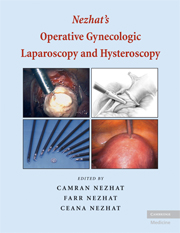Book contents
- Frontmatter
- Contents
- Contributing Authors
- Forewords
- Preface
- 1 HISTORY OF MODERN OPERATIVE LAPAROSCOPY
- 2 EQUIPMENT
- 3 ANESTHESIA
- 4 LAPAROSCOPIC ACCESS
- 5 LAPAROSCOPIC SUTURING
- 6 INTRAPERITONEAL AND RETROPERITONEAL ANATOMY
- 7 FERTILITY
- 8 HYSTEROSCOPY
- 9 MANAGEMENT OF ADNEXAL MASSES
- 10 ENDOMETRIOSIS
- 11 LAPAROSCOPIC ADHESIOLYSIS AND ADHESION PREVENTION
- 12 LEIOMYOMAS
- 13 HYSTERECTOMY
- 14 PELVIC FLOOR
- 15 LAPAROSCOPIC TREATMENT OF CHRONIC PELVIC PAIN
- 16 GYNECOLOGIC MALIGNANCY
- 17 LAPAROSCOPY IN THE PREGNANT PATIENT
- 18 MINIMAL ACCESS PEDIATRIC SURGERY
- 19 LAPAROSCOPIC VASCULAR SURGERY IN 2007
- 20 COMPLICATIONS IN LAPAROSCOPY
- 21 ADDITIONAL PROCEDURES FOR PELVIC SURGEONS
- 22 LAPAROSCOPY SIMULATORS FOR TRAINING BASIC SURGICAL SKILLS, TASKS, AND PROCEDURES
- 23 ROBOT-ASSISTED LAPAROSCOPY
- 24 HYSTEROSCOPY AND ENDOMETRIAL CANCER
- 25 OVERVIEW OF COMPLICATIONS
- Appendix
- Atlas
- Index
9 - MANAGEMENT OF ADNEXAL MASSES
Published online by Cambridge University Press: 23 December 2009
- Frontmatter
- Contents
- Contributing Authors
- Forewords
- Preface
- 1 HISTORY OF MODERN OPERATIVE LAPAROSCOPY
- 2 EQUIPMENT
- 3 ANESTHESIA
- 4 LAPAROSCOPIC ACCESS
- 5 LAPAROSCOPIC SUTURING
- 6 INTRAPERITONEAL AND RETROPERITONEAL ANATOMY
- 7 FERTILITY
- 8 HYSTEROSCOPY
- 9 MANAGEMENT OF ADNEXAL MASSES
- 10 ENDOMETRIOSIS
- 11 LAPAROSCOPIC ADHESIOLYSIS AND ADHESION PREVENTION
- 12 LEIOMYOMAS
- 13 HYSTERECTOMY
- 14 PELVIC FLOOR
- 15 LAPAROSCOPIC TREATMENT OF CHRONIC PELVIC PAIN
- 16 GYNECOLOGIC MALIGNANCY
- 17 LAPAROSCOPY IN THE PREGNANT PATIENT
- 18 MINIMAL ACCESS PEDIATRIC SURGERY
- 19 LAPAROSCOPIC VASCULAR SURGERY IN 2007
- 20 COMPLICATIONS IN LAPAROSCOPY
- 21 ADDITIONAL PROCEDURES FOR PELVIC SURGEONS
- 22 LAPAROSCOPY SIMULATORS FOR TRAINING BASIC SURGICAL SKILLS, TASKS, AND PROCEDURES
- 23 ROBOT-ASSISTED LAPAROSCOPY
- 24 HYSTEROSCOPY AND ENDOMETRIAL CANCER
- 25 OVERVIEW OF COMPLICATIONS
- Appendix
- Atlas
- Index
Summary
The adnexa are in an anatomic region in the pelvis that includes the ovaries, the fallopian tubes, and the structures within the broad ligament. The differential diagnosis of an adnexal mass is complex because of the wide spectrum of disorders that involve the adnexa. Most frequently, adnexal masses involve the ovary itself because of its inherent growth properties through ovulation and thus its propensity for neoplasia. During the evaluation of an adnexal mass, the picture may be further complicated as imaging does not always clearly delineate the adnexa from other nearby organs. An estimated 5% to 10% of women in the United States will undergo a surgical procedure for a suspected ovarian neoplasm during their lifetime. Although the majority of adnexal masses are benign in nature, the primary goal of the diagnostic evaluation is the exclusion of malignancy.
ETIOLOGY
The differential diagnosis of the adnexal mass varies with age (Table 9.1.1). Age is also the most important factor in determining the potential for malignancy. In fact, the risk that an ovarian neoplasm is malignant increases 12-fold from ages 12 through 29 and 60 through 69. Although there is emerging evidence that the presence of an adnexal mass in postmenopausal women is more common than once thought, masses found in premenarchal and postmenopausal women should be considered abnormal and must be promptly evaluated.
- Type
- Chapter
- Information
- Nezhat's Operative Gynecologic Laparoscopy and Hysteroscopy , pp. 179 - 250Publisher: Cambridge University PressPrint publication year: 2008

